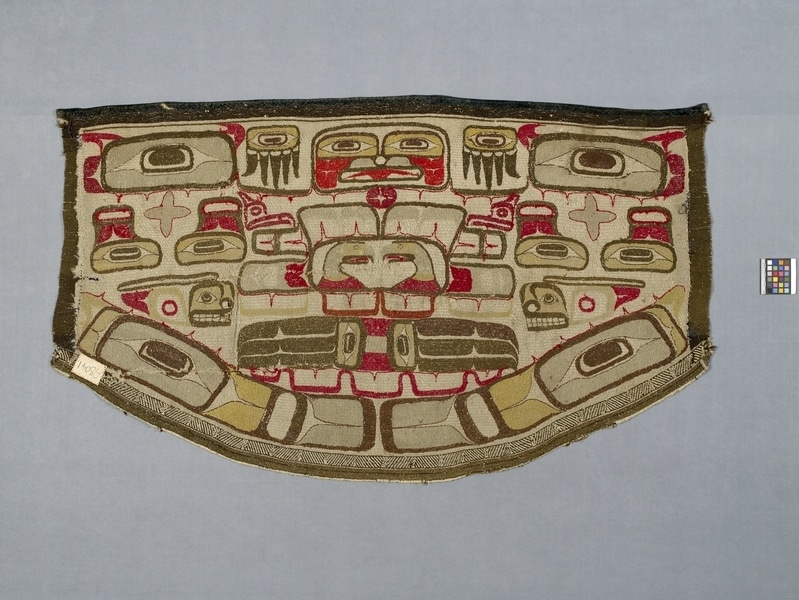Chilkat Robe Item Number: A8041 from the MOA: University of British Columbia


Description
Nuxalk style robe with woven designs. The design is like a three panel distributive, without the panels. The designs are red, yellow and black on natural ground. There are three eagle representations and two thunderbird heads in the centre, a human figure(?) near the top edge and killer whale motifs on the sides. The checkered border along the bottom edge is a raven’s tail design. There is a velvet band sewn along the top edge.
History Of Use
Chilkat blankets were originally made by northern Tlingit people, and traded down the coast to be worn on ceremonial occasions by Haida, Tsimshian and Central Coast chiefs. Chilkat robes were symbols of wealth: to own them endowed a chief with great prestige. Even greater prestige resulted from giving them away in potlatch. If there was no chief attending of high enough rank to receive it, the blanket might be cut into strips and distributed to a number of persons of prestige. These strips would be made into other ceremonial garments, such as shirts, aprons, leggings, headdresses, or bags. A chief would be dressed in his ceremonial regalia when he died and was laid in state.
Cultural Context
ceremonial
Iconographic Meaning
Emblems or crests distinguish different groups and symbolize their privileges. They can be shown on any material possessions, such as totem poles or robes, and each group owns the right to display specific crests.
Specific Techniques
Traditionally the design was first painted onto a pattern board by a man, then precisely copied in weaving by a woman. The style operated within strict conventions, but at the same time permitting subtle individual variations and originality. The weaving technique evolved from the craft of finger twining yellow cedar bark blankets. The background of light grey brown woolen warp is visible in this piece, similar to cedar bark weaving; the warp is held together with twining at half cm. Intervals. The coloured sections of the design are weft faced like the northern Tlingit blankets, with the warp completely covered by twined weft. The Chilkat loom is a single beam loom which consists of two upright posts, and a broad crossbeam from which the warp hangs freely. The warp ends are divided into sections and inserted into gut bags to keep the warps clean and untangled during twining. Weaving proceeds from top to bottom of the blanket, and extra warps are added when the design field is completed, in order to produce the curved border at the bottom.
Narrative
This blanket is different in colour, technique and design from Tlingit Chilkat robes. It was purchased by Edith Bevan Cross from the Hunt family (Kwagu'l) of Fort Rupert, however, stylistically the robe appears to be of Nuxalk origin (McLennan, 2019).
Item History
- Made in British Columbia, Canada before 1950
- Owned by Hunt Family
- Owned by Edith Bevan Cross before July 30, 1962
- Received from Edith Bevan Cross (Seller) and H. R. MacMillan (Funding source) on July 30, 1962
What
Who
- Culture
- Kwakwaka'wakw
- Previous Owner
- Hunt Family and Edith Bevan Cross
- Received from
- Edith Bevan Cross (Seller) and H. R. MacMillan (Funding source)
Where
- Holding Institution
- MOA: University of British Columbia
- Made in
- British Columbia, Canada
When
- Creation Date
- before 1950
- Ownership Date
- before July 30, 1962
- Acquisition Date
- on July 30, 1962
Other
- Item Classes
- textiles
- Condition
- fair
- Accession Number
- 0081/0003